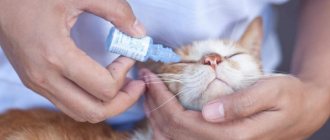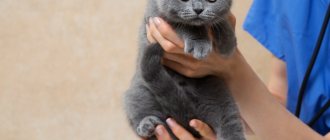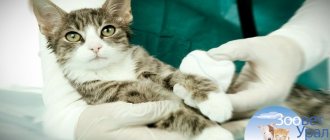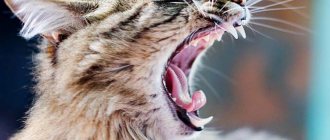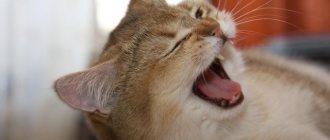A healthy cat's eyes should be clear, clear and shiny. The only acceptable deviation is dried lumps of tear fluid in the inner corners. If a cat’s eyes are watery, and the discharge is abundant and causes visible discomfort to the animal, the pet needs the help of a veterinarian.
How to examine a cat if its eyes are watery?
- As tragic as it may be, often the appearance of tears in a cat’s eyes indicates the presence of some kind of disease.
- Therefore, you need to pay attention to whether tears appeared for a short time and then disappeared, or whether the discharge in your cat’s eyes is present throughout the entire day, or worse, several days.
Tears
- If the cat’s tears are insignificant, and, having appeared in the morning, soon went away, there is nothing to worry about, and there is no reason for alarm.
- If your eyes “cry” for a long time, you should look for the cause of this phenomenon.
- When examining a cat with watery eyes, start by cleaning your hands to avoid further infection. Then try pulling down the upper eyelids on each eye .
- If the eyes are not cloudy, they shine, and the pupils are the same size, and the back surface of both eyelids is pale pink, and the cornea is transparent - everything is normal with the animal’s eyes.
Examine the animal
- If the eyelids are red or swollen, or the cornea is cloudy, this means that the cat has problems with the eyes.
- If the animal has difficulty opening its eyes or the inner surface of the eyelid is pulled up by a thin light film, it is better to visit a veterinarian as soon as possible.
Establishing diagnosis
Before starting treatment, it is imperative to conduct a diagnosis that will help identify the true cause of excessive lacrimation and carry out effective treatment therapy. Only a veterinarian can conduct a correct and thorough examination.
Important! Before going to the veterinarian, be sure to prepare a pet card, which should indicate all vaccinations, anthelmintic treatments, and past illnesses. It is advisable to write down symptoms of malaise and other suspicious signs on a piece of paper.
Sometimes the veterinarian may be interested in the following important questions at the appointment:
- how long the symptoms last;
- how did the first symptoms of tearing from the eyes appear and the peculiarities of the course of this condition, for example, did two eyes immediately begin to water at the same time, or vice versa, first one began, and then the other, and whether there are other additional symptoms;
- when the last procedures to eliminate helminths, fleas, ticks and other parasites were carried out.
To make an accurate diagnosis, the veterinarian will definitely take a urine and stool test. It is advisable to already have the research material with you before going to the doctor. Also, at the appointment, he will definitely take mucus from the eye for examination; for this reason, there is no need to first rinse the pet’s eyes with various solutions.
Cat's eyes are watery: causes and treatment
Reasons why a cat's eyes water:
- with a foreign body in the eyes . It could be some kind of speck, fluff, twig, midge, and possibly dirt. If you find something like this, the first thing you should do is rinse the animal’s eyes under running water. Once the foreign object has been washed, apply 1% tetracycline ointment to the cat's upper eyelid . It would be a good idea to show the animal to a veterinarian.
- Weakening of the immune system . This is possible if the kitten is taken away from its mother too early. But only a veterinarian can find out whether this is so. He will also develop a regimen for taking the necessary medications and adjust the animal’s diet.
- The presence of allergies , which, just like people, are inherent in cats. Allergens can be the same as for humans: dust, chemicals, pollen, etc. Here, consultation with a specialist is also necessary, since it is unlikely that the owner himself will be able to accurately determine both the allergy itself and the cause of its occurrence.
- Worms . This is a very common cause of watery eyes in cats. To exclude such a cause, the animal should be regularly treated for worms.
- Breed cats. There are several breeds that have a characteristic skull structure with a flattened nose and deformed nasolacrimal ducts. Only daily eye rinsing and special attention to hygiene in these risky areas will help.
Prone to watery eyes - Colds . If the cat also sneezes and coughs, sleeps most of the time and absorbs a lot of water, there is reason to suspect a cold . You should not treat the animal yourself; it is better to contact a veterinarian.
- Feline distemper is accompanied, in addition to discharge from the eyes, often with pus, high fever, diarrhea and vomiting, and general weakness. Self-treatment is unacceptable.
When to clean your eyes
Cat owners need to remember that they should not touch their pets' eyes unless absolutely necessary! It is forbidden to wash your eyes for the sake of prevention. There is no need to manipulate the eye area until abnormalities become visible that indicate disease or damage from a foreign object. This may manifest itself in the form of sticking of the eyelids, lacrimation, purulent discharge, and other similar symptoms.
When to cleanse your eyes:
- Preparation for the treatment of infectious diseases.
- Minor eye injuries (without compromising its integrity).
- Due to the anatomical and physiological characteristics of the lacrimal apparatus, which determine continuous or systematic tearing. These breeds include British Shorthairs, Scottish Folds, and Persians. For these cats, systematic eye washing is very necessary.
- Washing out small foreign particles that have entered the eye and cause irritation.
- For watery eyes caused by allergies. This procedure is carried out to reduce the concentration or wash out possible allergens. Sources of allergies can be household chemicals, pollen, dust and other similar substances.
Eye diseases that cause your cat's eyes to water
- Possible infection. If the eye becomes red and swollen, and pus appears, the help of a veterinarian is necessary, since feline conjunctivitis is possible.
- Direct eye disease , in particular cataracts or glaucoma . A whitened lens in the first case or a clouded cornea in the second are obvious symptoms of such diseases. Of course, treatment is only possible in a clinical setting.
- Diseases caused by viruses or fungi (such as chlamydia or toxoplasmosis) can only be treated by a specialist.
- An inflamed cornea is identified by red, watery eyes, on which a cloudy film appears.
- Entropion of the eyelid is often characteristic of Persians or, for example, sphinxes. Purulent discharge and swollen eyes are a reason to immediately visit a doctor.
- injury received if a cat got into a fight with a fellow cat, hit itself, got caught on a branch, etc. Wounds or other damage to the eyeball are symptoms of such an injury. It would be a good idea to consult a doctor to determine the severity of the injury.
From injury
You should also pay attention to the color of the discharge from the eyes.
- If the discharge is clear, similar to ordinary tears, it is most likely due to an allergy , mechanical irritation, or breed characteristics.
- If the discharge is green or yellow, mixed with pus , this indicates the presence of an infectious disease.
- If your cat's eyes are watery brown or red, it could be worms.
How to help an animal?
Only a specialist can accurately establish the cause and draw up the correct treatment regimen. But you can alleviate the animal’s condition before going to the veterinary clinic on your own. To begin with, it is important to pay attention to the symptoms accompanying lacrimation, in particular, fever, redness of the mucous membrane of the eye, diarrhea, lack of appetite, lethargy, and weakness . We further recommend:
- check that the cat has not suffered mechanical damage to the eye from a sharp or blunt object;
- make sure that the animal has not inhaled or swallowed household chemicals;
- Carefully rinse the eye with a decoction of medicinal herbs or a solution of furatsilin.
After this, the animal must be taken to a veterinarian, who will conduct a clinical examination and additional laboratory tests. In particular, to confirm the diagnosis, examinations such as:
- general examination to determine the presence of injuries or congenital deformities of the eyelids;
- analysis of discharge from the lacrimal sac for polymerase chain reaction, the presence of chlamydia and other bacteria;
- examination of the fundus (ophthalmoscopy);
- checking for patency of the nasolacrimal duct with instillation of fluorescein;
- ultrasound examination of the eye;
- general clinical tests.
In some cases, you can limit yourself to one analysis, while in others it is possible that a full diagnosis will be required. After the cause of lacrimation is determined, the doctor prescribes a treatment regimen and prescribes certain medications. The procedures themselves can be carried out at home, but at the same time follow the recommendations and do not get carried away with self-medication.
Why do Scottish Fold cats have watery eyes?
- As mentioned above, some cat breeds have a non-standard nasolacrimal duct, including Scottish, British, and Persian.
- Because of this, it does not completely remove the discharge, which is usually normal for any breed.
- The excess is eliminated through the eyes. If this happens after the cat has slept, then there is no need to worry, this is a normal physiological phenomenon.
Due to non-standard channel
- If your cat’s eyes are constantly watering , this is already outside the norm, and here it is necessary to find out the cause with the help of a veterinarian.
- Such cats need to wash at least once a week, and sometimes up to 2-3 times a day. If the discharge is normal, it is enough to wipe it periodically.
- If your eyes water frequently , you should contact a veterinarian and have your animal examined.
Tears associated with pathology
There are a large number of reasons for pathological lacrimation.
Allergies to dust, pollen, perfumes, and food products may be accompanied by lacrimation, sneezing and allergic rhinitis in the animal. Sensitive animals especially suffer from perfumes if their owners like to actively use perfumes and deodorants. In this case, lacrimation is observed from both eyes.
In young kittens (2-3 months old), watery eyes may be a sign of weakened immunity. They need outside help to take care of themselves.
Viral infections (calcivirosis, rhinotracheitis) are often accompanied by lacrimation. At the initial stage, the tear fluid may be clear, then it becomes purulent. The general condition of the animal is poor, it suffers from intoxication, high fever, rhinitis and other problems. With viral infections, both eyes become watery.
Bacterial conjunctivitis is accompanied by conjunctival hyperemia, lacrimation, pain and stinging in the eye. The tearing may be bilateral or one eye may be watering.
Eating a large amount of carbohydrate food (sweets, cakes, pastries, bread, cereals) can cause excessive tear secretion. Lacrimation is bilateral.
Anatomical defects, congenital or acquired (injuries, chronic infections that cause narrowing of the lacrimal canal) can lead to unilateral or bilateral flow of tears.
Entropion, or entropion of the eyelids, develops as a result of a genetic defect or a previous illness or injury. In this case, the eyelashes irritate and damage the delicate tissues of the eye and cause hyperemia and lacrimation. There are cat breeds that are prone to entropion (sphynxes, as well as rexes and other similar breeds). The affected eye waters.
Foreign body penetration, chemical (acid, alkaline) and thermal burns cause profuse lacrimation from the injured eye. The conjunctiva is hyperemic and the cornea may be damaged. It hurts the animal to blink and look. The cat squints, the tissue around the eye swells.
There are parasites that choose the eyes of pets as a place to stay. Sometimes they can be seen with the naked eye. Tearing can be quite profuse.
How to prevent your cat's eyes from watering?
- Of course, it would be much more correct to use hygienic methods so that the cat does not have to be treated later.
- Periodically rinse the animal's eyes with a cotton swab and warm water towards the spout.
Rinse
- If you notice dried discharge from the eye, soften it and carefully remove it, then use a clean swab to rinse the eye.
- Do not use the same tampon for both eyes, use new ones.
- If your cat's eyes are watery , do not use drops or medications without consulting a veterinarian, otherwise you may make the animal sick by using the medication incorrectly.
It is important to know
The decision of how and with what means to wash a cat’s eyes depends on the specific case. It is necessary to take into account the reason for which it was necessary to clean the eyes, as well as the individual reaction to any component in the composition of the drug.
If lacrimation is excessive
You can rinse your eyes with clean distilled water, but it is better with saline solution (with a salt concentration of 0.85%). This procedure will also help in removing dust, pollen, hairs and other small foreign bodies. If your pet has allergies, this method is the best.
If your eyes fester
In case of purulent exudate from the eyes or their sticking together (this happens after a while, when dry crusts appear), you need to drip the eyes with special antibacterial drugs, which are purchased at a veterinary pharmacy. This is necessary because pus is a symptom of infection.
Chlorhexidine for eye rinsing
Veterinarians do not agree on this issue, but the majority believes that it is possible. But you need to use chlorgesidine with a concentration of no more than 0.01%, then the use will be harmless.
Cleansing with furatsilin
Furacilin solution must be used with a concentration of maximum 0.02%, and the drug must also be sterile
It is important to know about possible individual intolerance to the substance; if it exists, then the use of furatsilin is prohibited
A cat's eyes are watery: prevention
- If there are no problems, then for prevention you can use warm decoctions of medicinal plants intended for people (St. John’s wort, chamomile, calendula, etc.), green tea, and drops without antibiotics.
- If the veterinarian determines that the cat’s eyes are watery due to an infectious disease, use tetracycline ointment.
- For established bacterial infections, “Diamond Eyes” and their analogues are used.

